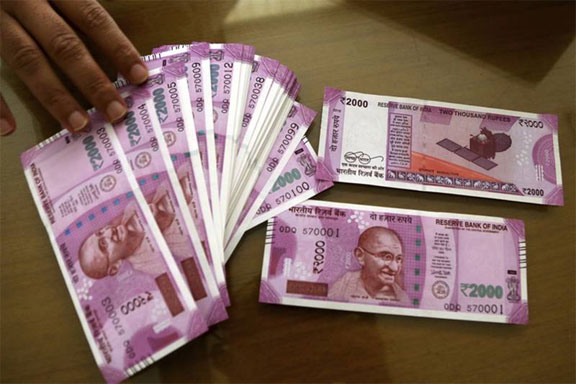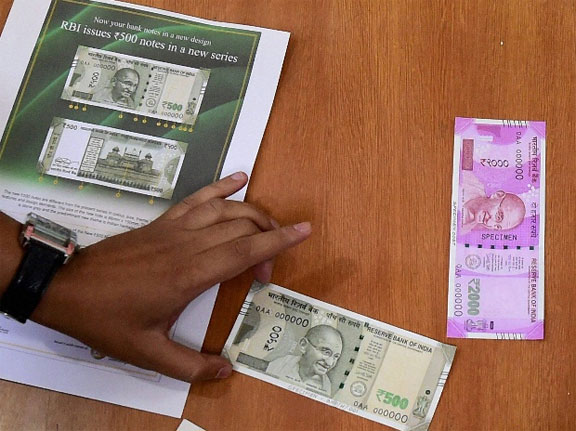“The demonetization move could change the face of the Indian economy.”
5:24 PM, Thursday, November 24th, 2016 The need for the government to keep the move a secret — so that tax evaders wouldn’t be alerted before the demonetization took place — affected preparedness. Jaitley admits it will take two-three weeks to reconfigure the ATMs to handle the newer and larger notes. A Rs 2,000 note has also been introduced. Modi has suggested it will take 50 days (until the end of 2016) for people to adjust to the change.
The need for the government to keep the move a secret — so that tax evaders wouldn’t be alerted before the demonetization took place — affected preparedness. Jaitley admits it will take two-three weeks to reconfigure the ATMs to handle the newer and larger notes. A Rs 2,000 note has also been introduced. Modi has suggested it will take 50 days (until the end of 2016) for people to adjust to the change.
Meanwhile, expensive marriages were called off. Deaths cannot be called off so easily — but the government catered to that by allowing payment at crematoria in old currency.
A Bold Move
 “This [demonetization] is a step which will make a positive difference, if the transition challenges get handled well by the administration,” says Jitendra V. Singh, Wharton emeritus professor of management. “We will need to be careful of potential attempts to derail this positive agenda.” The International Monetary Fund (IMF) echoes those sentiments. “We support the measures to fight corruption and illicit financial flows in India,” said a spokesperson. “Of course, given the large role of cash in everyday transactions in India’s economy, the currency transition will have to be managed prudently to minimize possible disruption.”
“This [demonetization] is a step which will make a positive difference, if the transition challenges get handled well by the administration,” says Jitendra V. Singh, Wharton emeritus professor of management. “We will need to be careful of potential attempts to derail this positive agenda.” The International Monetary Fund (IMF) echoes those sentiments. “We support the measures to fight corruption and illicit financial flows in India,” said a spokesperson. “Of course, given the large role of cash in everyday transactions in India’s economy, the currency transition will have to be managed prudently to minimize possible disruption.”
According to Mauro F. Guillen, a Wharton management professor and director of the School’s Lauder Institute, “In the short term, [the move] could stifle some businesses that are legal and clean, if they use cash payments. But everyone will adjust. And while it can hurt some small businesses and individuals, it is better to do it than not.”
Guillen adds that large-value currency is an “important source of problems” such as corruption, black money, terrorism and counterfeit money. “The eurozone will be eliminating the largest euro note. The U.S. is also trying to reduce the [number of] 100 dollar bills in circulation.”
The role of cash and high-value bank notes in the Indian economy cannot be understated. According to Reserve Bank of India (RBI) figures, as of March 2016 currency in circulation amounted to Rs16,415 billion. Of this, Rs500 notes accounted for 47.8% in value and Rs1,000 notes another 38.6%. Together, they were more than 86% of the value of the notes in circulation. That’s a whopping amount to be frozen in one fell swoop.
Understandably, banks and ATMs can do only so much. There’s a lot of tinkering to be done with limits and schedules of the exchange outlets and bodies authorized to take payments in old bills — state-owned electricity suppliers, for instance. To the credit of the government, this is being done on a continuous basis. But there are questions — especially from political parties — over their effectiveness.
Will It Work?
There are also questions over whether the “masterstroke” is masterful enough. “Black money is not synonymous with corruption; it is rather one of several symptoms of corruption,” notes Rajesh Chakrabarti, professor and executive vice dean of the Jindal Global Business School at Jindal Global University. Pointing out that only a small percentage (by some estimates as low as less than 6%) of the unaccounted wealth is held in cash, Chakrabarti says: “This intervention is a one-time draining of this current stock of black money but unless the root causes of corruption are removed, corruption will continue. It is sort of like a dialysis, more of a short term cleaning up than a solution of the problem. It needs to be repeated periodically.”
The Indian reality, adds Chakrabarti, is that many trades and areas are still cash-based and “cannot be digitized just by willing it.” He cautions that the “resulting disruption in the real economy stemming from this move is very significant and potentially fatal” for some vulnerable sections of society. “If some of the key areas are hampered, there is risk of mob violence and rioting. Since the entire country is at risk, there is no way of anticipating and preparing for this, either. So there is a risk of the situation getting out of hand as well.”
Simillar Posts
Warning: count(): Parameter must be an array or an object that implements Countable in /home/megamcaq/public_html/wp-content/plugins/post-plugin-library/common_functions.php on line 357
- None Found
Leave a Reply
© Copyright 2008 www.megamedianews.com All Rights Reserved. Privacy Policy








 Posted in
Posted in  Tags:
Tags: 



